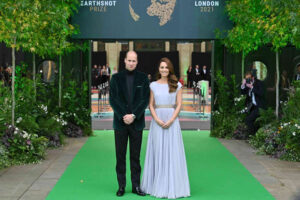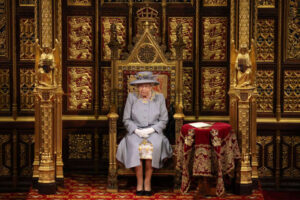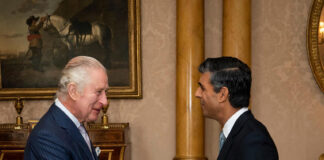SEPTEMBER 8, 2022
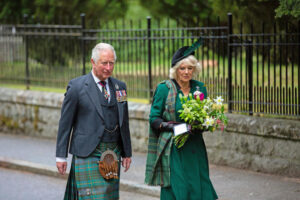
Prince Charles and his wife Camilla, Duchess of Cornwall, take part in a two-minute silence to mark the 75th anniversary of VE Day and laid flowers at the Balmoral War Memorial on May 8, 2020, near Crathie, Scotland. – Amy Muir/Pool/Getty Images
With the death Thursday of Queen Elizabeth II, thoughts immediately turn to her son. And the ascension of King Charles to the British throne promises to have a seismic effect on the roles of other royals orbiting the crown.
Succession isn’t the issue. That’s a simple matter of everyone in line moving up one step as Charles becomes King Charles III. Next up, of course, is his firstborn son, Prince William, and then William’s firstborn son, Prince George. And so on.
Instead, the looming question is what roles and duties will be taken on by royal relatives under a king who has been vocal about scaling back the British monarchy to placate those pushing to reduce taxpayer support for the extended royal family.
But in scaling back his team to a core group, the king will be walking a tightrope, experts say. While having fewer working royals on the payroll may appeal to republicans, such a skeleton crew may inherently detract from the pomp and circumstance that gives this centuries-old institution its magical appeal.
“We’ll likely be seeing a smaller group representing the crown, and there will be pros and cons to that,” says Carolyn Harris, historian at the University of Toronto and author of “Raising Royalty: 1,000 Years of Royal Parenting.”
On the con side, Harris foresees less frequent and shorter visits to the 54 Commonwealth countries, including Canada, Australia and New Zealand, which could lead to those nations debating whether to remove the British monarch as head of state. The Caribbean nation of Barbados already has.
On the pro side: “There will be a stronger line between who is representing the country and who is simply related to the royal family,” says Harris. “That’s in contrast to Queen Elizabeth, who brought in many cousins to help with tours and events as she oversaw a transition from empire to commonwealth.”
So who’s in and who’s out?
Royal watchers agree Charles is not likely to corral extended relatives into the crown’s affairs as his mother did with her cousin the Duke of Kent, most famous for his role handing out trophies to the victors at Wimbledon.
Rather, his tapered vision of the monarchy certainly will center on himself and his wife Camilla, who the queen decreed on the 70th anniversary of the accession in February is to be called Queen Consort.
The elevation in stature of Camilla – who when she wed Charles in 2005 it was announced she would be Princess Consort – is an acknowledgment of the way she has exercised her duties alongside her husband over the decades. That decorum included taking the title of Duchess of Cornwall, a purposeful avoidance of repeating the Princess of Wales title that had become so associated with the late Princess Diana.
The other key figures in Charles’ tight circle are likely to include Charles’ son William and his wife Kate, the Duchess of Cambridge; and Charles’ sister Princess Anne and his brother Prince Edward, along with his wife Sophie, Countess of Wessex. As for William and Kate’s three children, Prince George, 9, Princess Charlotte, 7, and Prince Louis, 4, they also are likely to play active roles as they get older.
Those not likely to represent the crown include Prince Andrew, Charles’ scandal-ridden brother, and Charles’ son Prince Harry, who famously pulled back from royal duties and lives in California with his wife Meghan, the Duchess of Sussex and their two children.
While it remains to be seen if Princess Beatrice and Princess Eugenie, Andrew’s daughters with ex-wife Sarah Ferguson, get called upon, the list isn’t likely to extend much beyond immediate family, says Nicoletta Gullace, associate professor of history at the University of New Hampshire.
“Metaphorically, heads may roll under the new king,” says Gullace, who specializes in British history. She says royals such as Prince Michael of Kent, another of the queen’s cousins on her father’s side, who lives on royal grounds and recently was in the news after being accused of selling access to the Kremlin, “could be out in the cold.”
But the downside of having just a few royals available for events is “there’s less fairy dust, less majesty,” Gullace adds.
There’s also the sheer impossibility of a small cadre of trusted royals handling all that is traditionally required of the monarchy. Charles himself will be fully occupied with meetings with foreign leaders and his own prime minister, leaving Camilla and William to take up the slack.
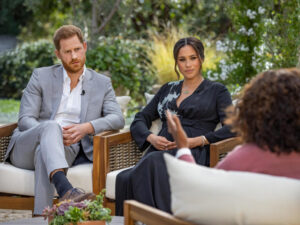
Prince Harry and Meghan, the Duchess of Sussex made headlines with their shocking Oprah Winfrey interview. – Harpo Productions/Joe Pugliese via Getty Images
How to maintain an ‘air of majesty’
“Everyone is going to be working hard and walking a fine line in any slimmed-down monarchy,” says Victoria Arbiter, longtime royal watcher and daughter of Elizabeth’s one-time press liaison, Dickie Arbiter.
Arbiter says a looming concern is “maintaining an air of majesty” while at the same time addressing issues ranging from politics to climate change. “And if there are only a few people doing all that, it’ll be easy for constituents and nations to feel slighted,” she says.
Another factor is age. Charles is 73, and his wife is 75. Although Elizabeth and her mother were vibrant into their 90s, it is unknown how active the new monarchy is apt to be. That will place more pressure on younger members of the royal family to be included, says Joe Little, managing editor of Majesty magazine.
“Maybe in the end what the royal family can even be expected to do needs to be streamlined,” he says. “There are only 24 hours in their days.”
Little says another critical factor is the difference between when Elizabeth assumed the throne and when her son did: In 1952, the world looked on in awe as a 25-year-old mother of young children suddenly became the sovereign. Charles’ rite of passage has been decades in the waiting and happened at a time when the institution itself is being scrutinized like never before.
“The problem for the monarchy is Charles can never be his mother, and besides this is a much more challenging job for him in these fraught political times,” says Anna Pasternak, veteran royal observer and author of “The American Duchess: The Real Wallis Simpson.”
Charles’ ascension plays into the hands of “today’s woke culture that sees him as an older white man of privilege.” Adding to the troubles facing his reign, she says, is the possibility of more broadsides from Harry and his wife, who leveled charges of racism against royal family members during their TV interview with Oprah Winfrey.
The ideal situation, says Pasternak, would be Charles deciding to abdicate in order for his more popular son and daughter-in-law to take over at a time when the monarchy needs stability and not more controversy. “He knows he has a limited window in which to prove to a modern world that he has credentials to take the country forward,” she says.
But abdication is unlikely, considering Charles’ apparent eagerness for the role after waiting so long. There is also the specter of that very traumatic event back in 1936, when the newly crowned King Edward decided mere months into his reign that he wanted to marry divorced American socialite Wallis Simpson and renounced the throne, paving the way for Elizabeth’s father to become king.
Charles will have his challenges. The sense that he will be ruling in a potentially crippling time for the House of Windsor is shared by royal watchers.
“There’s still some relevance, but the age of deference is long gone,” says Little. “There was some thought a while ago that the king could rely on his children to help him. But with Harry and Meghan pulling back and moving away, clearly, a rethinking is in order.”
In keeping with a smaller monarchy, royal experts do not expect Charles to dispense titles with abandon. He may choose to bestow some of the late Prince Philip’s titles on his brother Edward to bolster his status when executing royal duties.
But he is unlikely to offer titles to Harry and Meghan’s young children, given the rift between father and son. “I think it’s doubtful Charles will automatically make any of (Harry and Meghan’s) children princes or princesses,” says Christopher Andersen, author of several royal biographies including “The Day Diana Died” and “William and Kate: A Royal Love Story.” There is “simply too much bad blood on both sides.”
And even if the gesture were made, Harry and Meghan could well choose to reject it.
“Princess Anne said no thank you when titles were offered to her two children by the queen,” says Arbiter. “Similarly, Harry and Meghan could say ‘No thank you, we’re doing our own thing.’ ”
And there’s always the Diana factor
Charles’ reign may well last a while, given his family’s good genes. But royal experts say some of the problems he is facing as he assumes the throne would likely have been skirted altogether if – and ultimately when – William became king.
William and his wife are relatively popular and seem to have “more of that majesty about them,” says Gullace. “And they already seem to be grooming their son George to be a future leader.”
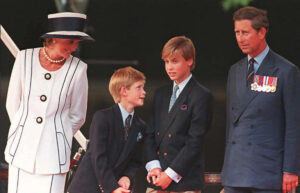
Princess Diana, her sons Harry and William, and Prince Charles watch a parade march outside Buckingham Palace as part of the commemorations of VJ Day in August 1995 in London. – AFP, AFP/Getty Images
And then there is the once and future king’s connection to the late Princess Diana, who continues to hold powerful sway over public consciousness, as evidenced by her story’s retelling in both Netflix’s “The Crown” and the film “Spencer.”
“Diana respected her mother-in-law and the institution of the monarchy,” says Arbiter, who knew Diana. The Princess of Wales’ family had served monarchs for years and she was proud her son would one day be king. “She was angry with Charles, for sure, but she wouldn’t have wanted to see the monarchy destroyed.”
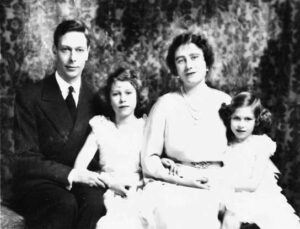
King George VI and his consort Queen Elizabeth (later the Queen Mother) pose with their two daughters, Princess Elizabeth, the future Queen Elizabeth II, center, and Princess Margaret, in 1937. – AP
That seems to be the challenge looming for the less-than-adored Charles III: keep a storied global institution going so that his popular son can one day ascend the throne. It may prove to be as deft a political feat as any monarch has been asked to pull off.


























































































